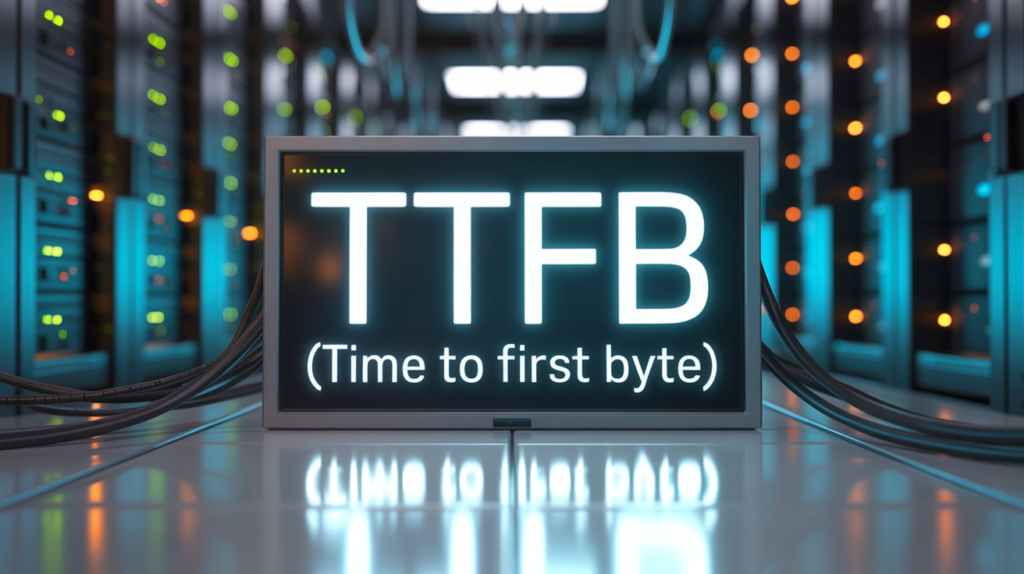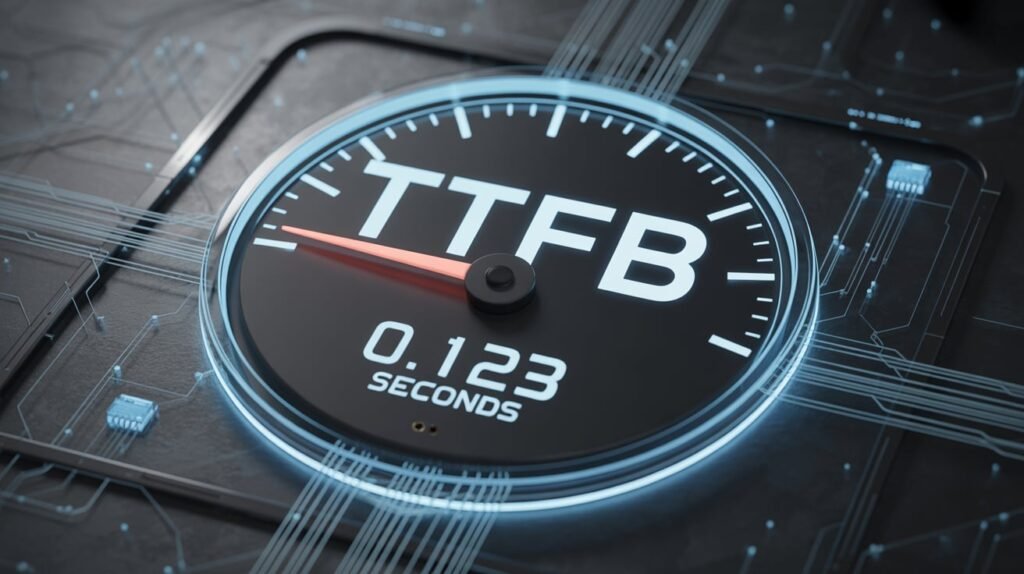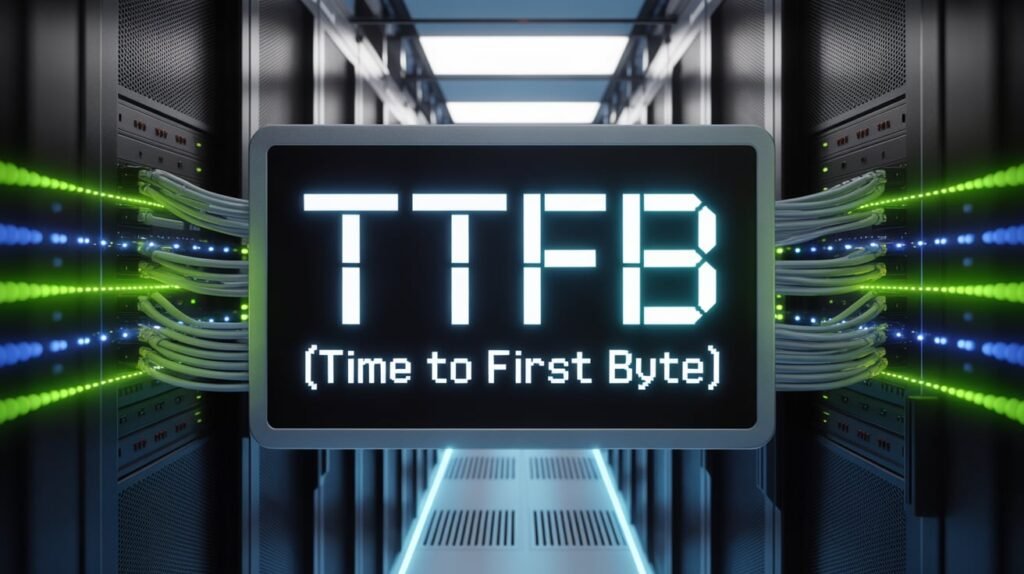Time to First Byte (TTFB) reflects how quickly your hosting server begins to respond to a browser’s request, and it’s one of the earliest indicators of how good (or bad) your web hosting truly is When measuring website speed, most people focus on page load times, image optimization, and caching. But there’s a deeper, more technical metric that can dramatically affect how fast your site feels.
What is TTFB?
Time to First Byte (TTFB) is the amount of time it takes between a user making a request (for example, by clicking a link or typing a URL) and their browser receiving the very first byte of data from the server.

It includes three main phases:
- DNS lookup and network connection time
- Request processing time on the server
- First byte delivery from server to browser
A fast TTFB indicates that the server is well-optimized and responsive. A slow TTFB points to potential hosting issues — slow backend processing, overloaded servers, or inefficient configurations.
Read Also: How to Prevent Website Downtime with Hosting: The Best Beginner-Friendly Guide 2025
Why TTFB Matters for Hosting Speed
While tools like Google PageSpeed Insights focus on metrics like Largest Contentful Paint (LCP) and First Input Delay (FID), TTFB is a foundational metric that affects everything that follows.
Here’s why a low TTFB is critical:
- Faster server response time means your entire site loads quicker.
- Better SEO performance, as Google factors TTFB into search rankings indirectly via Core Web Vitals.
- Improved user experience, especially for mobile or international users.
- Fewer bounce rates — slow first responses make users abandon before your site even loads.
- Lower server strain — efficient TTFB suggests better hosting resource management.
Ideal TTFB: What’s Considered Fast?
Generally speaking:
- Under 200ms: Excellent
- 200–500ms: Good
- 500–1,000ms: Acceptable, but could be optimized
- Above 1,000ms (1 second): Poor – indicates a server or configuration problem
ProTip: Keep in mind that TTFB can vary depending on the user’s location, server load, and site backend complexity.
Factors That Affect TTFB
Understanding the causes of high or low TTFB helps you diagnose issues and choose better hosting:

- Hosting Server Performance
Slow processors, high server load, or insufficient memory can delay how quickly a server begins responding. - Geographic Distance to Server
If your server is far from your user, TTFB increases due to longer network travel time. - Type of Hosting Plan
Shared hosting tends to have slower TTFB due to resource competition. VPS and dedicated servers usually offer better response times. - Web Server Software & Configuration
Servers running LiteSpeed or Nginx often outperform Apache in TTFB due to better handling of concurrent requests. - Backend Performance
Dynamic sites (e.g., WordPress or WooCommerce) depend on PHP and database queries. Slow scripts or unoptimized databases increase TTFB. - Content Delivery Networks (CDNs)
CDNs can reduce TTFB by caching and delivering content from nodes closer to users.
How to Measure TTFB Accurately
You can check your website’s TTFB using:
- Shows server response time clearly.
- WebPageTest.org: Provides detailed timing breakdowns.
- Google PageSpeed Insights: TTFB is listed under the “Server response time” section.
- Chrome DevTools: Under the Network tab, select a request and look at the Timing tab.
- Command-line tools: Use curl -w “%{time_starttransfer}\n” to measure TTFB manually.
Choosing Hosting Based on TTFB
When selecting a hosting provider with TTFB in mind, here’s what to prioritize:
- Opt for SSD or NVMe Storage: Disk I/O affects server-side response times. SSD and NVMe drives provide much faster read/write speeds compared to traditional HDDs.
- Choose LiteSpeed or Nginx Web Servers: These modern web servers handle connections and serve content faster than Apache, especially under load.
- Pick Servers Close to Your Audience: If your audience is in the US, choose a data center in the US. If they’re global, look for providers with global data center coverage or that offer free CDN integration.
- Go Beyond Shared Hosting: If performance matters, avoid cheap shared hosting. A VPS, managed WordPress hosting, or cloud hosting plan typically offers lower TTFB due to dedicated resources.
- Ask for Benchmarks: Reliable hosting companies often publish performance metrics. Look for independent benchmarks that include TTFB comparisons.
- Use Hosting with Built-in Caching: Platforms with server-level caching (like Redis, Memcached, or LiteSpeed Cache) reduce the need to regenerate pages, which lowers TTFB.
How TTFB Works
TTFB is the total time from when a client (usually a web browser) sends an HTTP request to a server until it receives the first byte of the response. It includes several distinct phases:
#1. DNS Lookup
- Before a browser can send a request to a server, it must resolve the domain name (like example.com) to an IP address using DNS (Domain Name System). This step introduces latency depending on DNS cache availability and DNS server speed.
#2. TCP Connection
- Once the IP address is resolved, the browser initiates a TCP handshake with the server to establish a connection.
- SYN (synchronize)
- SYN-ACK (acknowledgment from the server)
- ACK (final acknowledgment from the client)
- This process takes time, especially if the client and server are geographically distant.
#3. TLS Handshake (if HTTPS is used): For secure websites (using HTTPS), a TLS handshake occurs next. This step negotiates encryption protocols and shares certificates, to the total speed.
#4. HTTP Request Sent
- Once the connection is established, the browser sends the actual HTTP request (e.g., a GET request for the homepage) to the server.
#5. Server Processing
The server receives the request and begins processing it. This phase often contributes the most to TTFB and includes:
- Application logic execution
- Database queries
- Authentication checks
- Backend API calls
- The server must generate or retrieve the response content during this phase.
#6. First Byte Sent
- Once the server has generated the response, it starts transmitting data back to the client. The moment the first byte arrives at the browser, it is considered complete.
- DNS Lookup Time
- TCP Handshake Time
- TLS Handshake Time (if HTTPS)
- Time to Send HTTP Request
- Server Processing Time
- Time to Receive First Byte
Read Also: Role of IOPS and Disk Throughput in Web Hosting
How to Choose Hosting Based on TTFB
Choosing hosting based on TTFB (Time To First Byte) is a smart way to prioritize speed and performance; below are the things to consider before you can choose TTFB

#1. Check Independent TTFB Benchmarks
- Look for third-party speed tests (e.g., from WebPageTest, GTmetrix, or Bitcatcha) that include the results for various hosts.
- Compare TTFB across multiple regions.
#2. Avoid Shared Hosting for Critical Sites
- Shared plans often have higher TTFB due to server overload.
- Choose VPS, cloud hosting, or dedicated hosting for lower and more consistent TTFB.
#3. Choose Hosts with Global CDN Integration
- A CDN (Content Delivery Network) significantly improves TTFB for visitors far from the origin server.
- Prefer hosts that bundle or easily integrate with Cloudflare, Fastly, or similar CDNs.
#4. Select Data Center Location Closest to Your Users
- Physical distance affects TTFB. The closer your server is to your audience, the better.
- Many hosts offer multiple regions—pick the right one.
#5. Test TTFB Before Buying (if possible)
- Some hosts offer free trials or have demo/test sites.
- Use webpagetest.org to measure TTFB directly.
#6. Look for HTTP/2 or HTTP/3 Support
- These newer protocols reduce latency and improve TTFB.
- Check the host’s feature list or run a test on their demo site.
#7. Ask About Server Configuration
- Inquire about the use of LiteSpeed, Nginx, or optimized Apache—these affect TTFB.
- Hosts using LiteSpeed + caching often perform very well.
#8. Read Real User Reviews for Performance
- Focus on reviews that include hard metrics or user-reported TTFB data.
- Avoid vague performance claims.
#9. Use Hosting with Built-in Caching Layers
- Caching at the server level (object, opcode, or page caching) can drastically cut TTFB.
- Some hosts offer proprietary solutions like SiteGround’s SuperCacher or Kinsta’s server-level caching.
#10. Check Uptime and Load Handling
- High TTFB can be a sign of overloaded servers or poor scaling.
- Look for hosts with >99.9% uptime and proven load handling.
FAQs
Q. What is a good TTFB for a website?
A. A good TTFB is under 200 milliseconds. Anything under 500ms is acceptable. If it’s consistently over 1 second, it’s time to investigate server issues.
Q. Can plugins increase TTFB?
A. Yes. Poorly coded or resource-heavy plugins can delay backend processing, especially on platforms like WordPress. Keep plugins lean and updated.
Q. Does a CDN reduce TTFB?
A. Yes. A CDN can reduce TTFB for static content and help deliver assets faster by serving them from locations closer to your users.
Does switching hosts improve TTFB?
Absolutely. Hosting providers with better infrastructure and configuration can dramatically improve speed and overall site performance.
Q. How often should I check my TTFB?
A. Check it periodically, especially after making changes like switching themes, adding plugins, or changing hosting plans. Regular monitoring tools can also alert you to spikes.
Importance of TTFB in the Real World
- Imagine a user trying to access your site. If the TTFB is over 1 second, they may wait two or three seconds before any content starts to render, even before the first image or text appears. In the mobile-first, attention-deficit world we live in, that delay could be enough to lose a visitor or a customer.
- Whether you run a personal blog, e-commerce store, or SaaS platform, your site’s initial response time is part of your first impression. A low TTFB communicates speed, reliability, and professionalism. It’s not just about tech, it’s about trust.
Conclusion
TTFB is more than a technical metric; it’s a reflection of your hosting quality, server health, and backend efficiency. If your TTFB is slow, your entire site suffers, no matter how optimized your images or code are.
When choosing a hosting provider, pay attention to TTFB. Ask about data center locations, server configurations, and performance benchmarks. Test your current site regularly and don’t hesitate to upgrade if your hosting isn’t meeting your needs.
Fast first bytes mean fast first impressions. And in the world of web performance, that can make all the difference.

